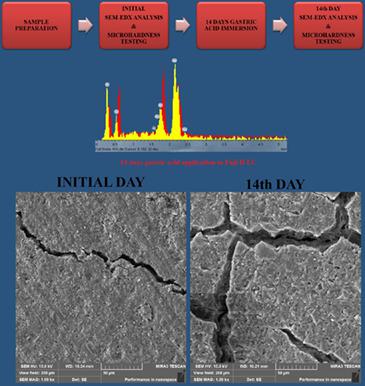当前位置:
X-MOL 学术
›
Microsc. Res. Tech.
›
论文详情
Our official English website, www.x-mol.net, welcomes your
feedback! (Note: you will need to create a separate account there.)
Evaluation of the microhardness of different resin-based dental restorative materials treated with gastric acid: Scanning electron microscopy–energy dispersive X-ray spectroscopy analysis
Microscopy Research and Technique ( IF 2.0 ) Pub Date : 2021-04-19 , DOI: 10.1002/jemt.23769 Murat Ünal 1 , Merve Candan 1 , İrem İpek 1 , Merve Küçükoflaz 2 , Ali Özer 3
Microscopy Research and Technique ( IF 2.0 ) Pub Date : 2021-04-19 , DOI: 10.1002/jemt.23769 Murat Ünal 1 , Merve Candan 1 , İrem İpek 1 , Merve Küçükoflaz 2 , Ali Özer 3
Affiliation

|
The aim of this study is to evaluate the microhardness, relative surface roughness, and elemental changes of resin-based dental restorative materials (RDRMs) after gastric acid treatment. Five different RDRMs (Group 1 [Filtek Z550], Group 2 [Beautifil II], Group 3 [Vertise Flow], Group 4 [Dyract XP], Group 5 [Fuji II LC]) were used. Samples were formed by using plexiglass molds of 10 mm diameter and 2 mm thickness. A total of 50 samples (n = 10) for microhardness tests and a total of 15 samples (n = 3) for scanning electron microscopy (SEM)–energy dispersive X-ray spectroscopy (EDX) analysis were prepared. All samples of each group were treated to gastric acid, simultaneously. A Vickers microhardness tester was used to evaluate the microhardness of the upper surfaces of each sample. SEM–EDX system was used for microstructure and elemental composition detection. The SEM–EDX, microhardness and relative surface roughness analysis were made prior to treatment in gastric acid for 14 days and analysis were repeated on the 14th day. As the difference in the microhardness values of RDRMs was compared, the time-dependent variation in all RDRMs was found to be statistically significant. It was observed that a drastic decrease in microhardness values was in Beautifil II, Filtek Z550, Vertise Flow, Fuji II LC, and Dyract XP, respectively. Average decrease rate of microhardness values compared to the initial state can be listed from high to low as Beautifil II (%35.72), Vertise Flow (% 28.88), Fuji II LC (% 21.09), Dyract XP (%17.60), and Filtek Z550 (% 16.58). As a result, in in-vitro conditions gastric acid decreased microhardness while increasing the relative surface roughness of RDRMs.
中文翻译:

用胃酸处理不同树脂基牙科修复材料的显微硬度评估:扫描电子显微镜 - 能量色散 X 射线光谱分析
本研究的目的是评估胃酸处理后树脂基牙科修复材料 (RDRM) 的显微硬度、相对表面粗糙度和元素变化。使用了五种不同的 RDRM(第 1 组 [Filtek Z550]、第 2 组 [Beautifil II]、第 3 组 [Vertise Flow]、第 4 组 [Dyract XP]、第 5 组 [Fuji II LC])。样品是通过使用直径为 10 毫米、厚度为 2 毫米的有机玻璃模具形成的。共有50个样品(Ñ = 10)为显微硬度试验,共15个样品(Ñ = 3) 用于扫描电子显微镜 (SEM)-能量色散 X 射线光谱 (EDX) 分析。每组的所有样品同时进行胃酸处理。维氏显微硬度计用于评估每个样品上表面的显微硬度。SEM-EDX系统用于微观结构和元素组成检测。在胃酸中处理 14 天之前进行 SEM-EDX、显微硬度和相对表面粗糙度分析,并在第 14 天重复分析。由于比较了 RDRM 显微硬度值的差异,发现所有 RDRM 的时间依赖性变化具有统计学意义。据观察,Beautifil II、Filtek Z550、Vertise Flow、Fuji II LC 和 Dyract XP 的显微硬度值分别急剧下降。与初始状态相比,显微硬度值的平均下降率可以从高到低依次为 Beautifil II (%35.72)、Vertise Flow (% 28.88)、Fuji II LC (% 21.09)、Dyract XP (%17.60) 和 Filtek Z550 (% 16.58)。因此,在体外条件下,胃酸降低了显微硬度,同时增加了 RDRM 的相对表面粗糙度。
更新日期:2021-04-19
中文翻译:

用胃酸处理不同树脂基牙科修复材料的显微硬度评估:扫描电子显微镜 - 能量色散 X 射线光谱分析
本研究的目的是评估胃酸处理后树脂基牙科修复材料 (RDRM) 的显微硬度、相对表面粗糙度和元素变化。使用了五种不同的 RDRM(第 1 组 [Filtek Z550]、第 2 组 [Beautifil II]、第 3 组 [Vertise Flow]、第 4 组 [Dyract XP]、第 5 组 [Fuji II LC])。样品是通过使用直径为 10 毫米、厚度为 2 毫米的有机玻璃模具形成的。共有50个样品(Ñ = 10)为显微硬度试验,共15个样品(Ñ = 3) 用于扫描电子显微镜 (SEM)-能量色散 X 射线光谱 (EDX) 分析。每组的所有样品同时进行胃酸处理。维氏显微硬度计用于评估每个样品上表面的显微硬度。SEM-EDX系统用于微观结构和元素组成检测。在胃酸中处理 14 天之前进行 SEM-EDX、显微硬度和相对表面粗糙度分析,并在第 14 天重复分析。由于比较了 RDRM 显微硬度值的差异,发现所有 RDRM 的时间依赖性变化具有统计学意义。据观察,Beautifil II、Filtek Z550、Vertise Flow、Fuji II LC 和 Dyract XP 的显微硬度值分别急剧下降。与初始状态相比,显微硬度值的平均下降率可以从高到低依次为 Beautifil II (%35.72)、Vertise Flow (% 28.88)、Fuji II LC (% 21.09)、Dyract XP (%17.60) 和 Filtek Z550 (% 16.58)。因此,在体外条件下,胃酸降低了显微硬度,同时增加了 RDRM 的相对表面粗糙度。











































 京公网安备 11010802027423号
京公网安备 11010802027423号